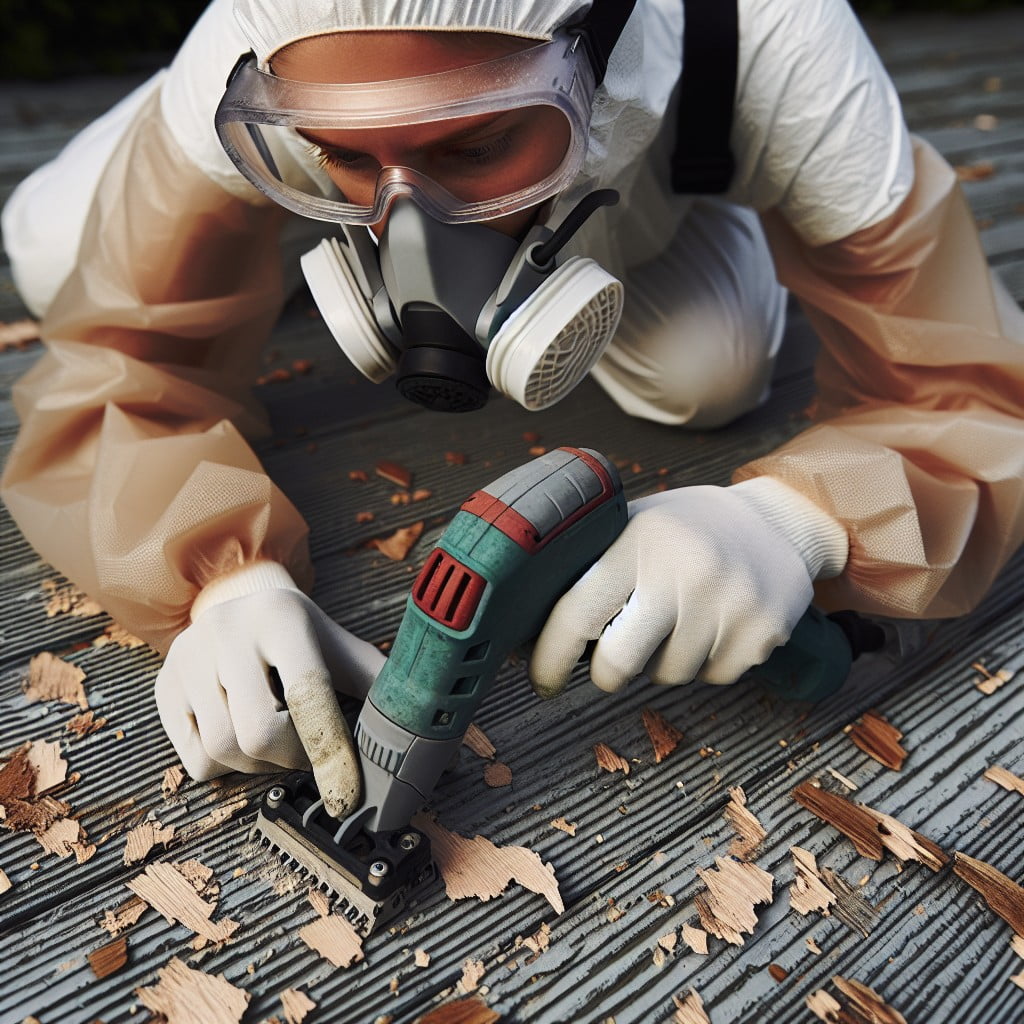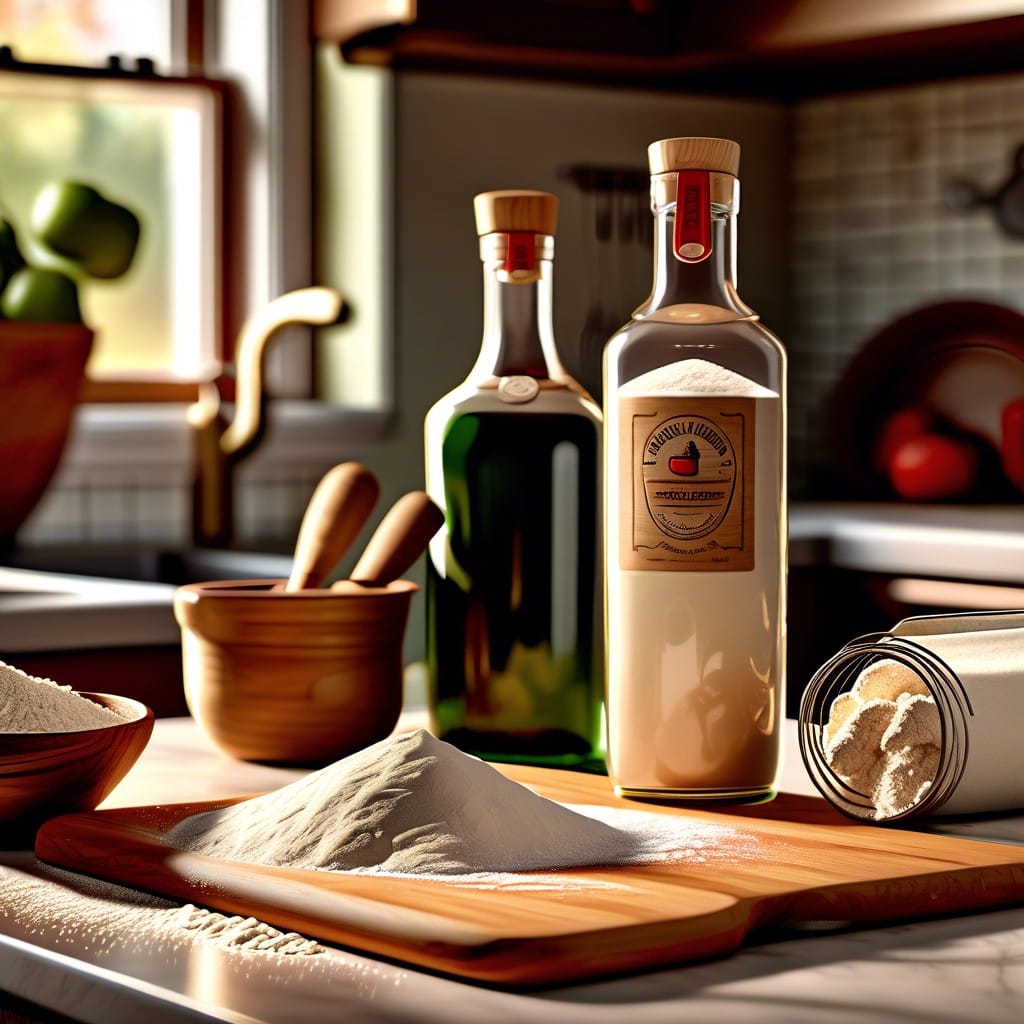Last updated on
Discover the green, less abrasive approach to clearing your deck of paint because reclaiming the natural beauty of your deck should not include harsh chemicals; let this comprehensive step-by-step guide show you the way.
Key takeaways:
- Determine the type of paint on your deck.
- Take safety precautions while removing the paint.
- Prepare the deck by clearing the area, sweeping the surface, and covering surrounding areas.
- Use a heat gun or a plastic putty knife to remove the paint.
- Sand the deck or use a pressure washer to further strip the paint.
Assess the Type of Paint On Your Deck

Determining the paint variety is crucial because removal techniques vary for water-based, oil-based, and acrylic paints. Water-based paints often react well to heat and mechanical removal methods, while oil-based paints may require a more rigorous approach due to their durability. Acrylics might present a unique challenge, as they’re plastic-based and could require a combination of heat and scraping to effectively remove.
Check the can if it’s available, or test a small area with heat to observe how the paint reacts—bubbling typically indicates a water-based paint, while a lack of reaction suggests oil-based. Understanding the paint type ensures you select the most effective, safe method for the task at hand.
Safety Precautions

Ensure your workspace is well-ventilated; outdoor areas are ideal for this type of project. Wear protective gear such as gloves, eye protection, and a dust mask to prevent inhaling any dust or debris.
Keep a first-aid kit nearby in case of scrapes or minor injuries. When working with a heat gun or sanding equipment, be mindful of hot surfaces and airborne particles. Secure loose clothing and tie back long hair to avoid entanglement in tools. Always follow the manufacturer’s instructions for any equipment you are using.
Keep children and pets away from the work area to prevent accidents.
Preparing the Deck for Paint Removal

Before diving into the paint removal process, it’s essential to get your deck ready to ensure the best results and protect its integrity.
1. Clear the Area: Remove all furniture, grills, and planters from the deck. This will provide unobstructed access to the surface and prevent any items from getting damaged.
2. Sweep the Surface: Give the deck a thorough sweep to remove loose debris, dirt, and leaves that could get in the way during the paint removal process.
3. Inspect the Wood: Look for any loose boards, nails, or screws. Repair these areas to prevent tripping hazards and to make sure your work is effective and even.
4. Cover Surrounding Areas: Use drop cloths or plastic sheeting to protect nearby plants and surfaces from any debris or accidental damage.
5. Check the Weather: Aim for a dry, overcast day with moderate temperatures. Extreme heat or cold can affect the efficacy of paint removal techniques, and rain can hinder your progress.
Once these steps are completed, the deck will be set for a safe and efficient paint removal experience.
Using a Heat Gun for Paint Removal

A heat gun can effectively lift paint from your deck by softening it, allowing for easier scraping without the need for harsh chemicals. When using a heat gun, keep it at a distance of a few inches from the wood surface and move it in a steady, back-and-forth motion to prevent scorching the wood. As the paint begins to bubble, gently scrape it away with a plastic putty knife, working in small sections to maintain control over the stripping process.
Remember to wear protective gloves and eyewear to safeguard against accidental burns or paint flecks. It’s also crucial to conduct this task in a well-ventilated area to avoid inhaling fumes.
Although the process may be time-consuming, the attention to detail will ensure a cleaner and more environmentally friendly result. After stripping the paint, sanding may be required to smooth the wood surface in preparation for refinishing.
Scraping Paint With Plastic Putty Knife
Once you’ve softened the paint with heat or a natural stripping solution, it’s time to remove it. A plastic putty knife is an ideal tool for the job to avoid scratching the wood.
Start by gently pushing the blade under the edge of the peeling paint and apply steady pressure to lift it away. Work in small sections, being careful not to gouge the deck with the edge of the tool.
For stubborn spots, reapply heat or solution to ease the process. Remember to dispose of the scraped-off paint responsibly. Keep a trash bin nearby to collect the debris as you work, keeping your workspace tidy and reducing the risk of staining.
Sanding the Deck to Remove Paint
Before you start sanding, choose the correct grade of sandpaper. Begin with a coarse grit to tackle thick layers of paint, and switch to a finer grit to smooth the surface afterward. Always sand in the direction of the wood grain to avoid scratching the deck. Wear a dust mask and goggles to protect yourself from airborne particles.
Furthermore, using an orbital sander can make the job quicker and more efficient, but if you prefer a manual approach, a sanding block can be effective for smaller areas. Remember to regularly check the surface as you work, to avoid over-sanding and potentially damaging the wood.
After sanding, sweep or vacuum the deck to remove all dust and debris before moving on to the next step of your deck restoration.
Utilizing a Pressure Washer
A pressure washer can be an effective tool for stripping paint from your deck. The high-pressure water jet lifts the paint from the wood, making it easier to scrape off. However, it’s crucial to use the right technique to avoid damaging the wood.
1. Choose the correct nozzle and pressure setting: Start with a 25-degree nozzle and a lower pressure setting to test how the wood reacts. Increase pressure cautiously.
2. Keep a consistent distance: Hold the spray tip about 12 to 18 inches from the deck’s surface and maintain this distance to ensure even cleaning without gouging the wood.
3. Use sweeping motions: Move the washer in smooth, overlapping strokes to evenly remove the paint. Start with the grain of the wood, and avoid staying in one spot for too long.
4. Avoid End Grain: The ends of the boards are more absorbent and vulnerable to damage. Angle the spray away from the end grain to prevent water saturation and possible wood swelling.
Remember, patience and steady movements will yield the best results without the need for harsh chemicals.
Natural Paint Softening Solutions
When chemical strippers aren’t an option, you can turn to more eco-friendly methods to soften paint before removal. Boiling water can be a surprisingly effective way to loosen paint. Simply pour the hot water over the painted areas and allow it to sit for a few minutes before scraping. This method works best on latex-based paints.
If hot water doesn’t do the trick, consider a homemade paste composed of baking soda and water. Apply this thick mixture to the affected areas, let it sit until the paint begins to bubble, then scrape off. The alkaline nature of baking soda helps in breaking down the paint.
Vinegar is another alternative; its acidity can soften paint without releasing harmful fumes. Heat the vinegar until it’s warm, apply it generously over the paint, and wait for 10 to 15 minutes. If the surface begins to wrinkle, it’s ready for scraping.
Remember, these methods may require more time and elbow grease compared to chemical strippers, but they are safer for your health and the environment.
Cleaning and Neutralizing the Deck’s Surface
Once you’ve successfully removed the paint, it’s essential to ensure that your deck is clean and neutral. Remaining residue from the paint or the removal process can hinder the absorption of any new treatments or stains you might want to apply.
Start by sweeping off any loose debris with a broom.
Rinse the deck with plain water using a garden hose to wash away any lingering particles.
For a deep clean, mix a solution of water and mild dish soap or a simple baking soda paste.
Apply the cleaning solution using a stiff-bristle brush, scrubbing gently to avoid damaging the wood.
Rinse thoroughly with water to remove all soap or baking soda residue.
If you’ve used a natural paint softener, neutralize the area by washing with a vinegar and water solution, which helps restore the pH balance of the wood.
Allow the deck to dry completely, ideally for a full day, before applying any stains or sealants for protection.
This cleaning and neutralizing step lays the groundwork for a fresh finish and prolongs the life of your deck, keeping it both functional and aesthetically pleasing.
Maintenance Tips After Paint Removal
Preserving the longevity of your freshly cleaned deck requires a few key practices. First, ensure your deck is sealed or stained appropriately to protect against weather elements. This acts as a shield to ward off moisture and UV damage, which can lead to wood degradation.
Regular sweeping to remove debris, leaves, and dirt will prevent mold and mildew growth. Keeping potted plants on stands and moving outdoor furniture periodically helps avoid discoloration and wood rot.
Inspect your deck annually for any signs of wear and address them promptly. This includes looking for loose boards or protruding nails that may need to be fixed or replaced to maintain the integrity of the deck.
Lastly, consider a gentle cleaning schedule using just soap and water to maintain the deck’s appearance without exposing it to harsh elements. Proper care ensures your deck remains a beautiful and safe space for relaxation and entertainment.
FAQ
What is the fastest way to remove paint from a deck?
The quickest method to remove paint from a deck involves using chemical strippers coupled with power washing, as this is less laborious and more efficient than solely relying on mechanical procedures like scraping and sanding.
Will vinegar remove paint from deck?
Yes, vinegar can be used for mild paint removal from a deck; however, its effectiveness is not as high as commercial paint strippers.
What is the easiest way to remove paint from wood?
The easiest way to remove paint from wood is by using a paint stripper, which is a solvent that softens the old finish, making it easy to remove.
What is the best product to remove paint from a deck?
The best products to remove paint from a deck include the DEFY Exterior Wood Stain Stripper, the SaverSystems Deck Wood Stain Stripper, and the Dumond Chemicals Smart Strip Advanced Paint Remover.
Can a heat gun be used for paint removal from a deck?
Yes, a heat gun can be used for removing paint from a deck.
Does sanding effectively remove paint from wooden decks?
Yes, sanding can effectively remove paint from wooden decks.
What household items can be used to strip paint from a deck?
Household items that can be used to strip paint from a deck include a heat gun, paint scraper, or a solution of vinegar and baking soda.
Recap:




